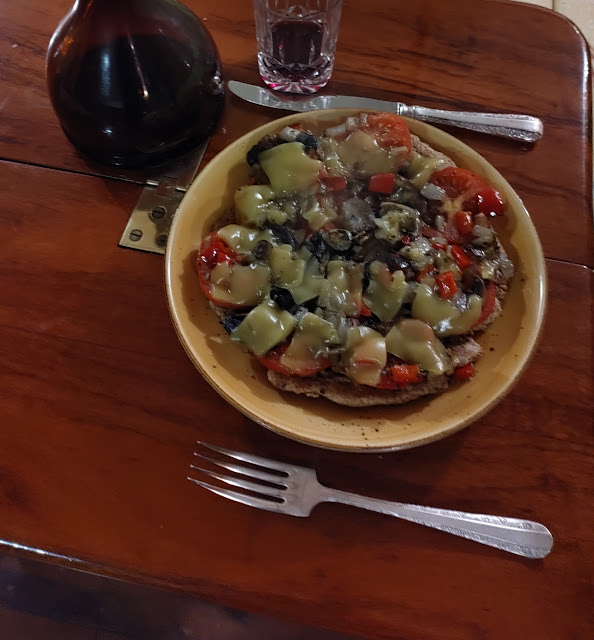- If you’re using an oven, pre-heat it to a moderate heat.
- Put the oil and water into a small mixing bowl and mix them together. You can use seawater, if you prefer, and leave out the salt.
- Add the salt and the yeast and then blend in the flour with a spatula or something similar.
- When the ingredients have combined into a dough, knead this gently for a couple of minutes. You will probably need a little more flour for this.
- Roll the dough out so that it fits your frying pan or baking sheet. Leave it to rise for at least a quarter of an hour, longer if you're very organised. If you are in a cold place, warm the frying pan or put something like a night light in the oven to keep the dough warm.
- Cook over a hot flame on a flame tamer for about 10 minutes, or cook in a hot oven for the same time. Turn the base over and add the topping.
- Heat the oil in a pan. Add the onion and garlic and fry until softened.
- Lower the heat and add the tomatoes and mixed herbs. Cook until most of the moisture has evaporated, leaving a thick sauce. This depends a lot on your tomatoes - you may need to add some tomato purée to thicken it up. On the other hand, add a little wine or water if the mix looks very dry.
- Throw in the olives.
- Take the half-cooked pizza base, turn it over and spread the sauce over the base, right to the edges, spreading it carefully and as evenly as possible.
- Grate over as much cheese as you want.
- Turn down the heat and put the pizza back to cook (covered, if you’re using a frying pan), until the cheese has melted.
- If you don’t have fresh tomatoes, you can use a couple from a can. Put the rest of the tomatoes into a glass jar and use them the next day (or put them in the fridge). Or you can use some passata, if you have some. If all else fails, just use tomato purée suitably diluted with water.
- For vegans, leave off cheese and sprinkle with generous amounts of "Parmegan". Alternatively, this is one place where vegan 'cheese' is acceptable. I've heard that there is some excellent vegan cheese around, but have yet to find any in New Zealand.
- Top with microgreens or rocket (arugula), if you're lucky enough to have some.
- Pepperdews, mushrooms, or sliced green or red peppers, all go well with the above.
- A great alternative topping to the tomatoes is sun-dried tomato pesto.
- If you don’t have black olives, try green olives instead. The stuffed ones are particularly good.
- Add a tsp capers with the olives.
- If you've got fresh tomatoes with a really good flavour, you can simply slice them quite thickly and lay them out on the pizza dough. Cook a few mushrooms and a little red pepper and put those on top with some olives and capers, and cheese if you have it.
- If you are getting short of inspiration, row ashore and wander along to the nearest pizza parlour. You’ll soon get a whole slew of new ideas!
Pizza made with dairy cheese and topped with microgreens









